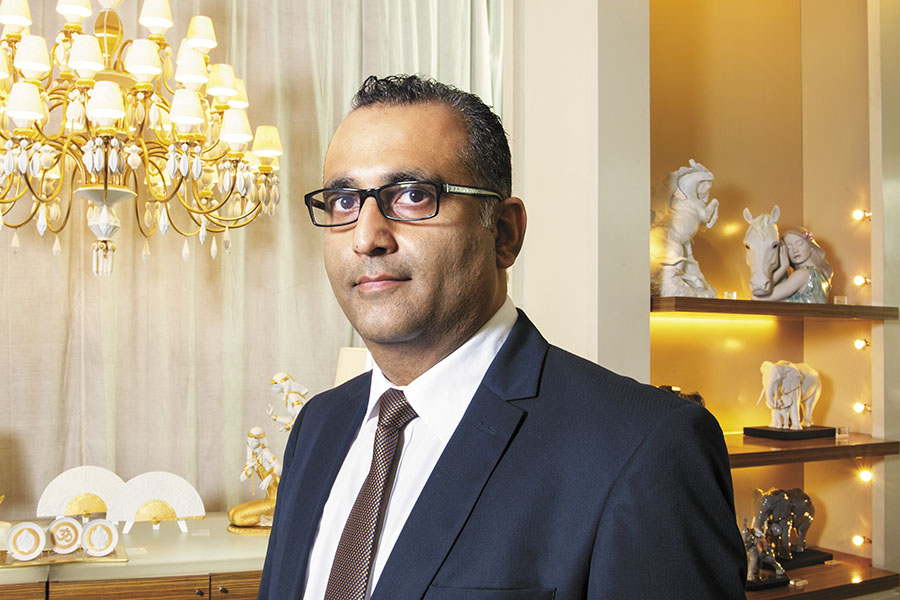
We sell more deity figurines to Indians in the US than here: Lladro India COO
Spanish luxury brand Lladró's porcelain pieces have found their way into many affluent Indian households, resulting in a 15 percent average growth in sales in the country each year

Lladró India’s Coo Nikhil Lamba says his company has started weaving technology and art to create new products
Image: Amit Verma
Spanish handmade porcelain luxury label Lladró caters to the unique taste of Indians, not only in India but also across the world. Founded in 1953, the company, based in Valencia, Spain, sells figurines of gods and goddesses for as high as Rs 7 lakh apiece. In an interview to Forbes India, Nikhil Lamba, chief operating officer of Lladró India, says it sells more figurines of Indian deities in the US than it does in India, reflecting the global success that Indian professionals and entrepreneurs have achieved over the years. The brand is now expanding its bouquet of offerings to more affordable pieces like scented candles and table lamps, so that more Indians can own a piece of Lladró. Edited excerpts:
Q. How big is the market for luxury porcelain sculptures that you sell in India?
It is a niche segment, and within that, we have been doing well. People have been buying our products for gifting, as well as self-consumption purposes. As a category, we fall under home decor. So it isn’t really a need-based item. We are proud to have products available for all occasions that resonate with our Indian clientele—be it a wedding anniversary or a religious festival like Diwali.
We have been expanding our range of products too. A lot of people aren’t aware that we also have products like a fragrance candle with a beautiful packaging which starts at Rs 3,700. We have also expanded into decorative lighting. So it is not just sculptures; we have table lamps mounted on sculptures, porcelain chandeliers and wireless LED table lamps that cost about Rs 25,000 and can be charged via a USB port. So there is a little bit of technology being weaved in our art as well.
There are, of course, porcelain figurines that we are well known for. We have launched a limited edition statue of Lord Shiva, which costs Rs 7.10 lakh. In the past, we have also come out with figurines of Goddess Lakshmi, Lord Krishna and Ganesha apart from well-known personalities like Mahatma Gandhi and Mother Teresa.
Q. How has Lladró been growing in India?
We entered India in 2000 when we were importing our products and selling them through dealers. We started a joint venture with an Indian partner [SPA Agencies India] in 2006 and have been continuously investing in India. We have eight boutique stores in the country. It has been a good ride here and we have seen sales growing at an average of 15 percent each year. I cannot comment on specific sales numbers since we are a privately held company. About 35-40 percent of our sales in India come from our India-specific portfolio known as the Spirit of India, while the remaining comes from our international product basket.
When we refer to our Indian clientele, we not only mean customers in India, but also Indians across the world, especially the affluent ones in countries like the US. The first Indian product that we launched was in 2000. It was an idol of Lord Ganesha and it was a big success in the US. So for a lot of our future products, we not only take feedback from customers in India, but also from Indian customers across the world. We sell more high-porcelain pieces to Indians in the US, than we do to Indians in India. The average ticket price of the products that we sell in India is Rs 50,000.
Q. Apart from the Indian pieces, what are your other popular offerings in India?
Lladró is well known globally for statues of horses. These are available in different finishes—glazed or matte—and they do very well in India. Then we have sculptures depicting couples, ballet dancers, mother and child, and sportspersons like a golfer or a batsman. Our products are all about feelings, and good, happy moments.
Q. Considering that you operate in a niche segment, how do you go about building awareness regarding the Lladró brand and its offerings among potential clients?
A lot of brand promotion happens through word of mouth in our business. We have observed that if someone is gifted a Lladró piece, that person also wants to gift a Lladró piece to someone else. We also do events such as special signing ceremonies for customers who make high-value purchases. At these events, Rosa Lladró, president of the company and a member of the founding family, signs the piece, adding to its exclusivity, and also interacts with the customers. We also have a sculpting event, where one of Lladró’s sculptors comes from Spain and offers customers a first-hand experience of how a Lladró piece is created.
Q. Like the artwork of famous painters, do Lladró’s creations also command significant resale value?
There are people who trade in Lladró artefacts internationally though we don’t promote this as a brand. In markets like the US, people also trade online. There are some collector websites on which some exclusive Lladró pieces are listed. In 2010, we launched a high porcelain sculpture of Lord Ganesha, which was priced at Rs 7 lakh. This was a limited edition with only 99 pieces. People are willing to pay as much as Rs 12 lakh for it. But since we have sold out the edition, if someone wants to acquire this piece, they will have to look for it privately. Though typically in India, people don’t want to part with an idol of a deity for religious and sentimental reasons.
(This story appears in the 23 December, 2016 issue of Forbes India. To visit our Archives, click here.)














